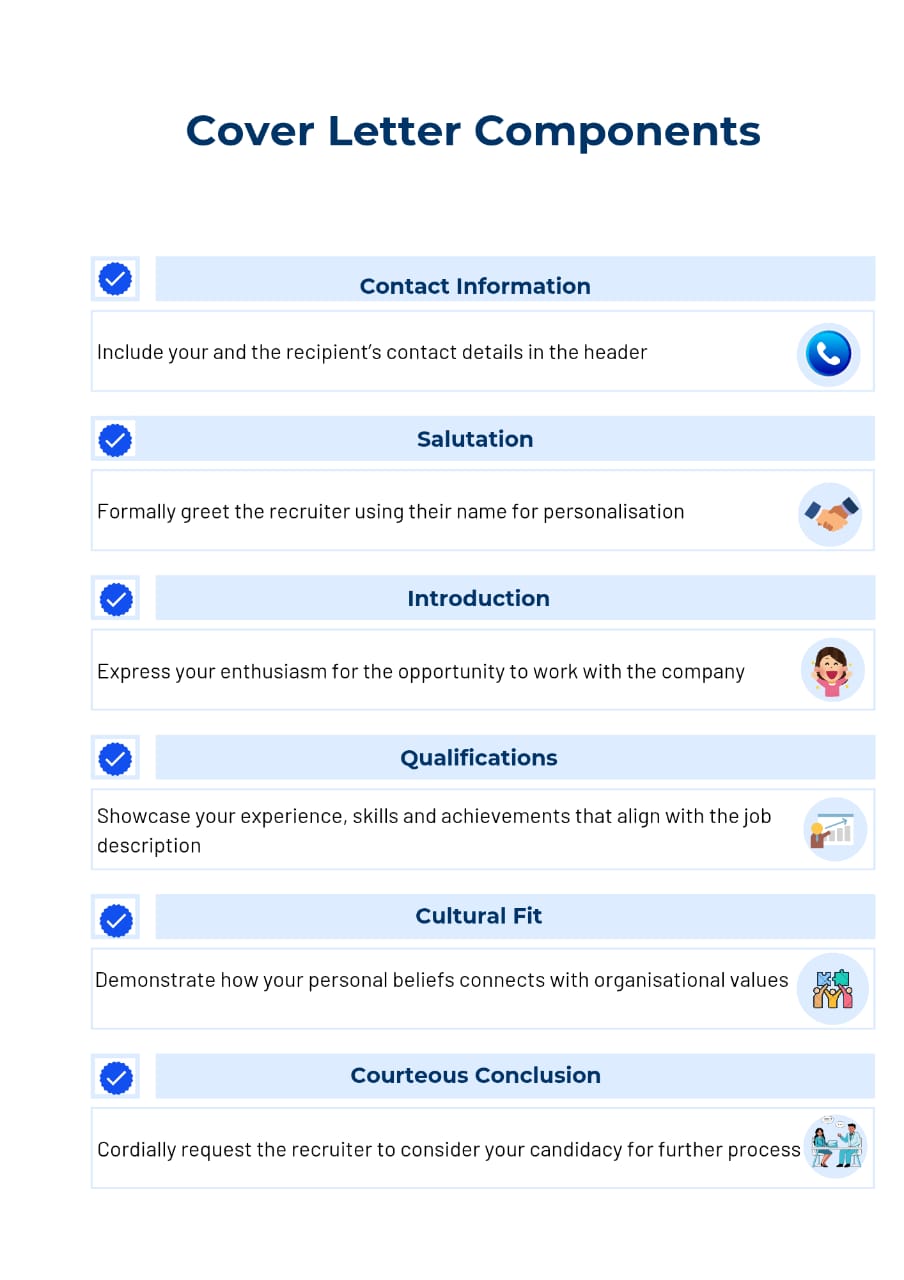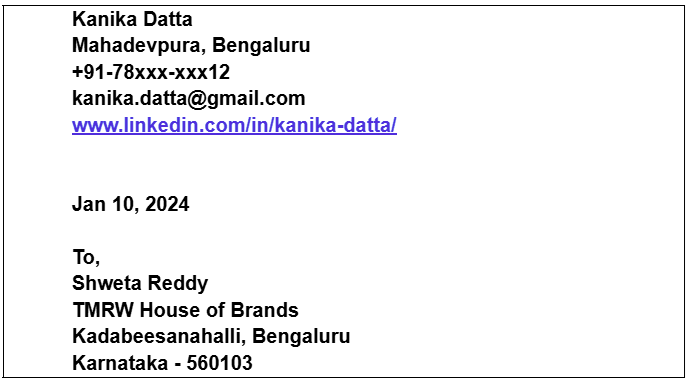Most job seekers feel that writing a cover letter along with a resume is a taxing job. With the changes in the process of job application over the years, some even feel it is pointless to have a cover letter, as employers may not even take the time to read them.
Do We Really Need a Cover Letter?
Now, before dismissing the idea of a cover letter just because “it is too much work”, let’s consider the statistics.
A study by Resume Genius consolidates the views of hiring managers on cover letters, which indicates that
- 83% of recruiters review cover letters even when they do not ask for one.
- 94% of hiring managers report that cover letters influence their decision regarding interviews, with one in four considering them to be “highly significant”.
- 49% of hiring managers believe that a compelling cover letter results in an interview. Whereas 18% observes that a poorly written one undermines an otherwise qualified candidate.
Clearly, as we see, cover letters are not going anywhere. There are reasons they still occupy a significant place in the job application process. As a job seeker, including a cover letter in your application is a desirable professional etiquette even when they are not always explicitly requested for.
If you are wondering how to begin, this article will walk you through the art of effortlessly crafting an enticing cover letter that will grab the attention of recruiters with guiding examples while also highlighting their importance.
What is a Cover Letter and How is it Different From a Resume?
A cover letter is a supplementary document, not longer than 400 words, that is sent along with a resume as a part of a job application process. It is an introductory letter addressed to prospective employers briefing them about the position you are interested in, your relevant professional experience and what makes you deserving of the role you are pursuing.
While it is logical to think that there are similarities between a resume and a cover letter, they prominently differ in terms of format and content.
A resume succinctly showcases your relevant qualifications, skills, experience and achievements, while a cover letter offers a unique opportunity to convey your personality, passion and fit for the role.
Essentially, a resume indicates who you are and what you have done; meanwhile, a cover letter highlights what you want to do and why.

Are Cover Letters Valued ?
While screening the job applications, recruiters are looking for candidates who not only match the job specification but also benefit the organisation by addressing their requirements.
This is where your cover letter steps in. You can share a tailored story with specific experiences and skills that ties back to the position you are applying, appropriately connecting the dots between your experience and employer needs.
How to Write an Effective Cover Letter. A Step-by-Step Guide.
The best cover letters are straightforward, less wordy and easy to skim. Here’s how to write a model cover letter that will straight away get you to the interview room.
1. Contact Information
The first thing you need to do is to fill up your header with the contact details. Regardless of the template you use, the top of your letter must reflect how to reach you and the person you are writing to.
Example:

Points to note:
- Your email address must be professional.
- Always share a working phone number.
- Links to social media, websites or personal portfolios are optional.
- Always mention the current date.
- Mention the recipient’s name, if not available, use proper designation such as, Hiring Manager, Head – Human Resources etc.
- Use brief address. Simply mention the city and state if the address is longer.
- Listing contact details is not required if you are sending an email.
2. Acknowledge the Hiring Manager
The second most important part is to professionally address the recipient. If possible, use their name to personalise your letter. Write the surname in the traditional business letter style. for e.g., “Dear Mr. Sen”. If you cannot ascertain their gender, you may write the full name instead.
If you are unsure of their name, “Dear Hiring Manager” is an acceptable alternative, though it’s best to avoid generic greetings when you can.
3. Write an Engaging Introduction
Trust me on this, your introduction pitch decides whether the recruiter will continue reading the letter or move on to the next application. So, you need to be as conspicuous as possible.
There is no fixed formula to create an impression, however based on some common patterns in most successful cover letters, the more it is about them (the company) and not only about you (the candidate), the more it strikes a chord with most employers.
- Introduce yourself and mention the position you are applying for.
- Go ahead with what interests you about this role. What is your intrinsic motivation?
- In case you know a mutual connection, mention them.
- You can also share your most notable achievements from past experiences with measurable metrics.
- Do in-depth research about the company, understand their unique mission statement and analyse how your professional aspirations align with their vision.
- If you learnt that the company has recently merged with another brand, share if you had a similar experience in the past and how you navigated through the transition.
Let’s refer to an example of a fashion designer applying for the role of Team Leader:

In this example, the candidate expresses her enthusiasm and attempts to make a connection with the employer by resonating their mission statement with her professional aspirations.
You may choose to begin with whichever way that makes your candidature strong, as long as it exhibits your authentic self.
4. Explain your Competency Tailoring to the Job Criteria
Now that you have expressed your willingness to work for the company, you need to tell the prospective employer about the qualifications you possess that makes you the right candidate for the job.
- Utilise this section to highlight your relevant skills, experience and achievements, providing context to match the job requirements.
- Start by carefully analysing the job description. Identify the key responsibilities, required skills and any specific qualifications mentioned therein. Make a list of your own qualifications that align with these criteria.
- Next, weave your skills and experiences into a compelling narrative. Use specific examples to illustrate how you have successfully applied these skills in previous roles that will clearly convey your work outcomes.
Continuing the example of the fashion designer showcasing her know-how:
“With 10 years of experience in fashion design, I possess a unique blend of creative vision, technical skills, and industry knowledge that makes me an ideal fit for this role. My expertise spans sketching, garment construction, and prototyping, with demonstrated proficiency in CAD and design software such as Adobe Illustrator, Sketchbook Pro and Optitex. During my stint at Zudio, a well-known fashion brand, I successfully led the design team in developing and launching several best-selling collections that exceeded sales targets by 30% and received positive customer feedback. My experience in managing the design-to-production process has equipped me with the skills to drive efficiency, quality and innovation in product development and brand management.”
This approach not only highlights her capabilities but also promises her potential impact within the new role.
Tailoring your cover letter for different positions is an essential step in the job application process that can boost your chances of landing an interview.
5. Showcasing Personality and Fit
Having the right skills and qualifications for the job is good news, but what’s great is sharing similar values that make you culturally fit for the job role.
What makes you excited about working with this company alone and not others?
Employers want to see who you are as a person and how you would be a part of their team culture. This section gives you an opportunity to convey your compatibility with the culture and environment of the company.
Dig into the company history, values, recent developments, industry position and social responsibility. Gain insights into their products and services, territorial presence and community engagement. Identify aspects that resonate with your own professional experiences or values.
Reinforce your enthusiasm by stating how the position aligns with your future goals or how you admire the company’s achievements.
Proceeding with the example of the fashion designer affirming her interest for the company:
“I am particularly drawn to TMRW House of Brands commitment to innovation, quality standards, and customer-centricity, which aligns with my own values and approach to design. My experience working with fast-fashion brands has taught me the importance of staying ahead of the curve in terms of trends, technology, and consumer behavior. I am excited about the prospect of joining a team that shares my passion for fashion, innovation and customer satisfaction.”
In this example, our candidate finds herself within the core values and principles of the company, intriguing her willingness to associate with the company.
Validating cultural alignment proves beneficial to employees and organisations alike by enhancing employee engagement and productivity.
6. Closure
Write a brief concluding paragraph expressing your gratitude towards the reader’s time and effort in reviewing your application. Restate your enthusiasm for the position and mention that you are available for interview at any given time. Finally, end with a professional closing such as “Best Regards”, “Warm Regards”, or “Thank You”.
The fashion designer in our previous example winds up with the following statement:
“Thank you for your time and consideration. I am excited about the opportunity to contribute to TMRW House of Brands and believe that my skills and experience are ideally suited to this position. I would welcome the opportunity to discuss my qualifications further and explore how I can make a positive impact and contribute to company goals.”
Handy Tips for Perfecting Your Cover Letter Before Submission
Do review your cover letter before submitting it to the employer. Your cover letter is your first point of communication, as it holds possibilities of further action by your prospective employer. Hence, it is crucial to ensure that it is well written and error-free. To achieve that, you may want to follow the checklist below
- Scrutinise the text for correct formatting with consistent font size, even spacing and appropriately set margins.
- Read your cover letter to check for incoherent phrases and see to it that the content is engaging enough.
- Revisit the job posting and check that your qualifications, skills, and experiences match the job description.
- Incorporate keywords from the job description to optimize for Applicant Tracking System (ATS).
- Take your time to carefully proofread for spelling mistakes, punctuation and other grammatical errors.
By following these guidelines, you will be well on your way to crafting a compelling cover letter that resonates with potential employers and sets you apart from the competition. So, take these insights, give them your own voice, and let your passion shine through. We can’t wait to hear about the doors your stellar cover letter will open for you!
Also Read: Resume Trends in 2025 : Everything You Need To Know About Modern Resume Writing
Cover Letter Tips By Indeed
